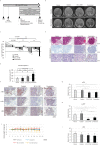Therapeutic effects of the novel Leucyl-tRNA synthetase inhibitor BC-LI-0186 in non-small cell lung cancer
- PMID: 31205503
- PMCID: PMC6535710
- DOI: 10.1177/1758835919846798
Therapeutic effects of the novel Leucyl-tRNA synthetase inhibitor BC-LI-0186 in non-small cell lung cancer
Abstract
Objective: Leucyl-tRNA synthetase (LRS) is an aminoacyl-tRNA synthetase catalyzing ligation of leucine to its cognate tRNA and is involved in the activation of mTORC1 by sensing cytoplasmic leucine. In this study, the usefulness of LRS as a therapeutic target of non-small cell lung cancer (NSCLC) and the anticancer effect of the LRS inhibitor, BC-LI-0186, was evaluated.
Methods: LRS expression and the antitumor effect of BC-LI-0186 were evaluated by immunohistochemical staining, immunoblotting, and live cell imaging. The in vivo antitumor effect of BC-LI-0186 was evaluated using Lox-Stop-Lox (LSL) K-ras G12D mice.
Results: LRS was frequently overexpressed in NSCLC tissues, and its expression was positively correlated with mTORC1 activity. The guanosine-5'-triphosphate (GTP) binding status of RagB was related to the expression of LRS and the S6K phosphorylation. siRNA against LRS inhibited leucine-mediated mTORC1 activation and cell growth. BC-LI-0186 selectively inhibited phosphorylation of S6K without affecting phosphorylation of AKT and leucine-mediated co-localization of Raptor and LAMP2 in the lysosome. BC-LI-0186 induced cleaved poly (ADP-ribose) polymerase (PARP) and caspase-3 and increase of p62 expression, showing that it has the autophagy-inducing property. BC-LI-0186 has the cytotoxic effect at nanomolar concentration and its GI50 value was negatively correlated with the degree of LRS expression. BC-LI-0186 showed the antitumor effect, which was comparable with that of cisplatin, and mTORC1 inhibitory effect in a lung cancer model.
Conclusions: BC-LI-0186 inhibits the noncanonical mTORC1-activating function of LRS. These results provide a new therapeutic strategy for NSCLC and warrant future clinical development by targeting LRS.
Keywords: BC-LI-0186; aminoacyl-tRNA synthetase (ARS); leucyl-tRNA synthetase (LRS); mTORC1; non-small cell lung cancer (NSCLC).
Conflict of interest statement
Conflict of interest statement: The authors declare that there are no conflicts of interest.
Figures





Similar articles
-
Leucine-induced localization of Leucyl-tRNA synthetase in lysosome membrane.Biochem Biophys Res Commun. 2017 Nov 18;493(2):1129-1135. doi: 10.1016/j.bbrc.2017.09.008. Epub 2017 Sep 5. Biochem Biophys Res Commun. 2017. PMID: 28882589
-
Control of leucine-dependent mTORC1 pathway through chemical intervention of leucyl-tRNA synthetase and RagD interaction.Nat Commun. 2017 Sep 29;8(1):732. doi: 10.1038/s41467-017-00785-0. Nat Commun. 2017. PMID: 28963468 Free PMC article.
-
Combination of the LARS1 Inhibitor, BC-LI-0186 with a MEK1/2 Inhibitor Enhances the Anti-Tumor Effect in Non-Small Cell Lung Cancer.Cancer Res Treat. 2023 Jul;55(3):851-864. doi: 10.4143/crt.2022.1527. Epub 2023 Mar 20. Cancer Res Treat. 2023. PMID: 36960627 Free PMC article.
-
Aminoacyl-tRNA synthetases and amino acid signaling.Biochim Biophys Acta Mol Cell Res. 2021 Jan;1868(1):118889. doi: 10.1016/j.bbamcr.2020.118889. Epub 2020 Oct 20. Biochim Biophys Acta Mol Cell Res. 2021. PMID: 33091505 Review.
-
Targeting autophagy using small-molecule compounds to improve potential therapy of Parkinson's disease.Acta Pharm Sin B. 2021 Oct;11(10):3015-3034. doi: 10.1016/j.apsb.2021.02.016. Epub 2021 Feb 26. Acta Pharm Sin B. 2021. PMID: 34729301 Free PMC article. Review.
Cited by
-
Roles of Aminoacyl-tRNA Synthetases in Cancer.Front Cell Dev Biol. 2020 Nov 27;8:599765. doi: 10.3389/fcell.2020.599765. eCollection 2020. Front Cell Dev Biol. 2020. PMID: 33330488 Free PMC article. Review.
-
Riddle of the Sphinx: Emerging Role of Transfer RNAs in Human Cancer.Front Pharmacol. 2021 Dec 15;12:794986. doi: 10.3389/fphar.2021.794986. eCollection 2021. Front Pharmacol. 2021. PMID: 34975491 Free PMC article. Review.
-
Functional and pathologic association of aminoacyl-tRNA synthetases with cancer.Exp Mol Med. 2022 May;54(5):553-566. doi: 10.1038/s12276-022-00765-5. Epub 2022 May 2. Exp Mol Med. 2022. PMID: 35501376 Free PMC article. Review.
-
Dickkopf 4 Alone and in Combination with Leucyl-tRNA Synthetase as a Good Prognostic Biomarker for Human Colorectal Cancer.Biomed Res Int. 2023 Apr 15;2023:9057735. doi: 10.1155/2023/9057735. eCollection 2023. Biomed Res Int. 2023. PMID: 37096225 Free PMC article.
-
tRNA Metabolism and Lung Cancer: Beyond Translation.Front Mol Biosci. 2021 Sep 30;8:659388. doi: 10.3389/fmolb.2021.659388. eCollection 2021. Front Mol Biosci. 2021. PMID: 34660690 Free PMC article. Review.
References
-
- Siegel RL, Miller KD, Jemal A. Cancer Statistics, 2017. CA Cancer J Clin 2017; 67: 7–30. - PubMed
-
- Park SG, Choi EC, Kim S. Aminoacyl-tRNA synthetase-interacting multifunctional proteins (AIMPs): a triad for cellular homeostasis. IUBMB Life. 2010; 62: 296–302. - PubMed
-
- Lee SW, Cho BH, Park SG, et al. Aminoacyl-tRNA synthetase complexes: beyond translation. J Cell Sci 2004; 117(Pt 17): 3725–3734. - PubMed
-
- Kim S, You S, Hwang D. Aminoacyl-tRNA synthetases and tumorigenesis: more than housekeeping. Nat Rev Cancer 2011; 11: 708–718. - PubMed
LinkOut - more resources
Full Text Sources
Molecular Biology Databases
Research Materials
Miscellaneous

